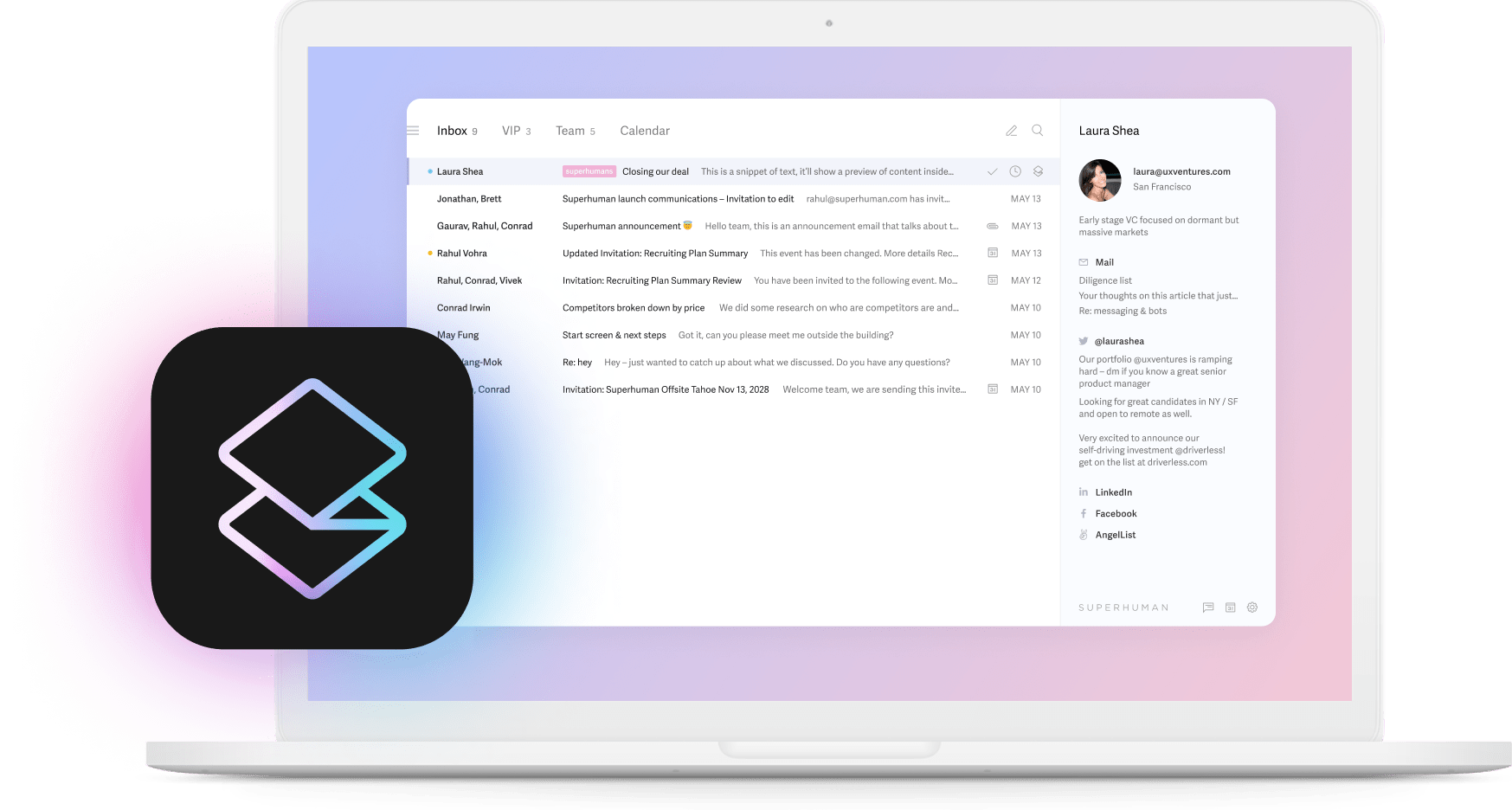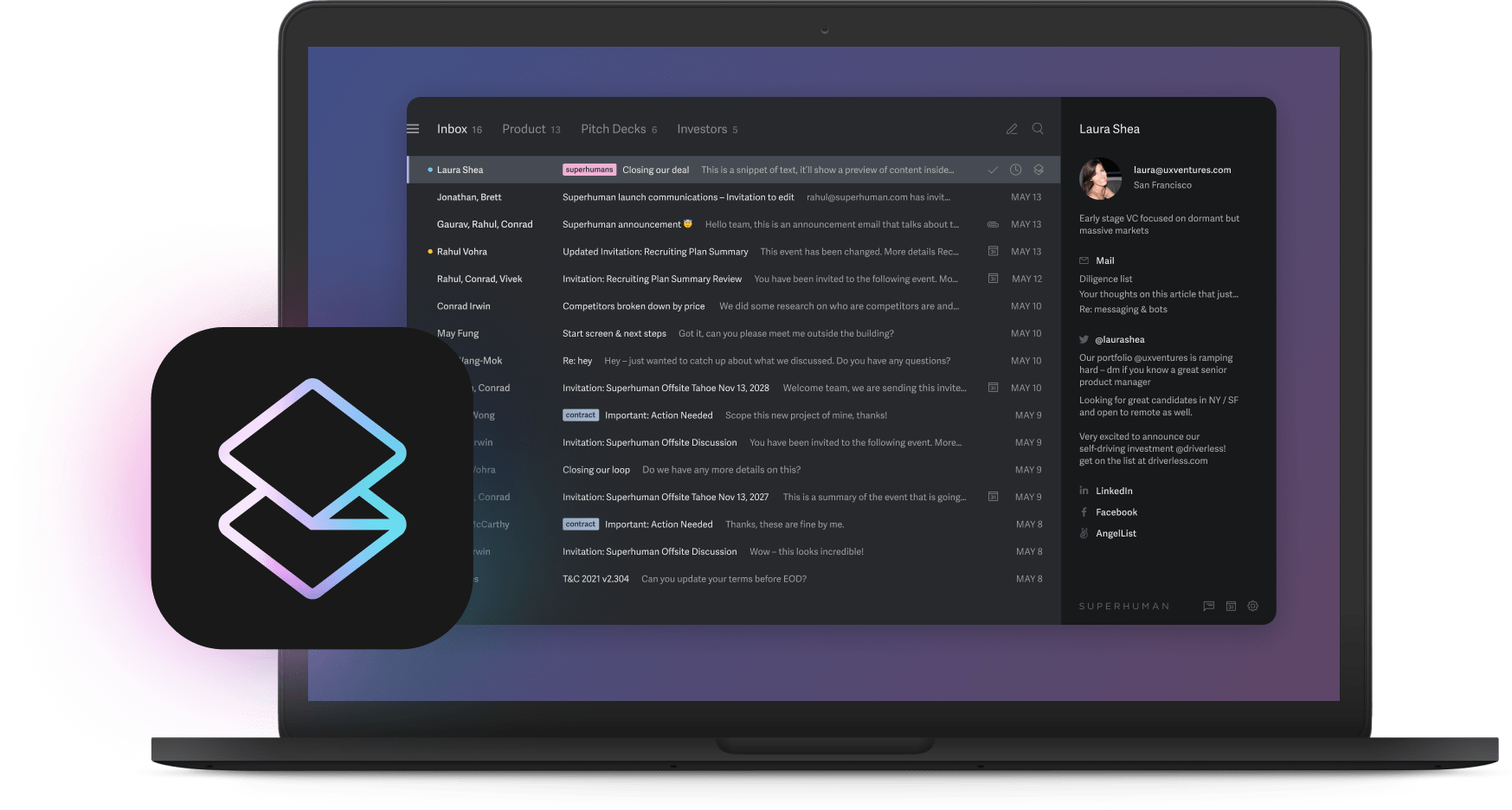
You open your inbox Monday morning and see 100s of unread emails. Most are GitHub notifications. Some are JIRA updates. Buried somewhere in there is a message from your CEO about the board meeting. And three alerts that production is on fire.
Welcome to the engineering inbox problem. Your email mixes robot messages with human messages, urgent alerts with routine updates, critical decisions with automated noise. Everything looks equally important until you miss something that really matters.
The good news? Split Inbox and Auto Labels in Superhuman solve this mess. These features give you an organized system that surfaces critical information while keeping the noise under control. And with the new libraries offering 60+ instant configurations, you can transform your chaotic inbox in about five minutes.
Why engineering email is fundamentally different
Engineers face a unique email challenge that other roles don't understand.
Automated overload: You've got GitHub sending you every comment on every PR. CircleCI emails you about every build. Datadog tells you when metrics cross thresholds. PagerDuty wakes you up at 3 AM. Each tool thinks its messages are the most important thing in the world.
Mixed urgency levels: One minute you're reading about a database optimization. The next, someone's asking about vacation policy. Then a customer bug report shows up. Your brain constantly shifts gears, which makes everything take longer.
Team coordination chaos: Modern engineering means working with product managers, designers, QA engineers, and ops teams. Each group communicates differently. Product folks write novels. Ops sends terse alerts. Designers attach 50MB mockups.
Hidden time bombs: Here's what keeps you up at night. Some emails matter right now. A production alert can't wait. A security patch needs immediate attention. But these urgent messages look exactly like the 200 other emails you got today.
Split Inbox sorts the chaos automatically
Split Inbox divides your email into organized sections. Instead of one massive list, you get separate views for different types of messages. Each section shows only what belongs there.
The Split Inbox Library offers pre-built configurations designed for how engineers work. Pick the ones that match your workflow. Or build custom splits for your specific needs. Either way, you go from chaos to clarity fast.
Getting Split Inbox running in minutes
The fastest way to get started is with the Split Inbox Library. Here's how:
Step 1: Open Split Inbox options
- Desktop users: Navigate to Settings ⚙️ → Split Inbox Library
- Mobile users: Pull down and search for Split Inbox Settings
Step 2: Enable the splits you need
Popular splits for engineering teams include:
GitHub: Captures all your commits, pull requests, and code discussions. Now you can review code in focused batches instead of constant interruptions.
Linear: Keeps sprint updates, task changes, and planning discussions organized. Track project progress without drowning in notifications.
Jira: Groups all your tickets, comments, and status changes. Handle project management between coding sessions, not during them.
Slack: Many teams route Slack notifications to email. This split catches them so nothing important gets lost in the shuffle.
Additional useful splits:
- Notion or Confluence for documentation collaboration
- Figma for design feedback and updates
- DocuSign or PandaDoc for contracts and paperwork
Want something more specific? You can always create custom splits with your own rules. The library gives you a head start, but Split Inbox is fully customizable.
Step 3: Arrange your priorities
Drag splits into whatever order works for you. Many engineers prefer:
- Starred messages (for anything critical you've flagged)
- GitHub (code reviews when you're ready)
- Linear or Jira (project updates between tasks)
- Notifications (everything else that can wait)
Watch it work: An engineering lead's transformed mornings
An engineering lead at a fintech startup used to dread mornings. Before Split Inbox, opening the laptop meant facing hundreds of emails. Which ones mattered? Who knows.
Now they open Superhuman and immediately see what needs attention:
- 3 starred messages including a production alert
- 8 messages in GitHub, mostly PR reviews to batch later
- 12 notifications in Linear about sprint updates
- 15 general notifications that can definitely wait
They handle the production issue, unblock their developer, and know exactly when to review those PRs. What used to take 45 minutes now takes 20. Coding starts by 9:30 instead of 10:15.
Auto Labels add instant context
Split Inbox organizes your email into sections. Auto Labels do something different. They tag individual messages with visual indicators. You see at a glance what each email is about.
You can create your own Auto Labels with custom rules and AI prompts. But the Auto Label Library makes getting started simple. It has pre-built labels for engineering workflows. No setup needed. Just pick the ones that help you work faster.
Activating Auto Labels that matter
The quickest path is through the Auto Label Library:
Step 1: Find Auto Label options
- Desktop: Navigate to Settings ⚙️ → Auto Label Library
- Mobile: Search for Auto Label Settings (currently iOS only)
Step 2: Turn on engineering-focused labels
Key labels for engineering workflows:
respond: Identifies messages needing your reply. Never leave teammates hanging again.
signature: Catches documents requiring your signature. Those NDAs and contracts won't slip through.
mention: Highlights when tools specifically call you out. Know when your input really matters.
meeting: Groups scheduling coordination. Keep calendar chaos contained.
recruiting: Tags hiring-related messages. Essential when growing your team.
Power up with custom AI labels
Business and Enterprise Superhuman customers can create AI-powered labels with custom rules. This gets really powerful for specific workflows.
Want to catch performance problems before customers complain? Here's how:
- Navigate to Settings ⚙️ → Auto Labels → Create New
- Write an AI prompt: "Emails about slow queries, high latency, or response time issues"
- Add a rule: From contains "monitoring@" OR subject contains "ALERT"
- Save and watch it work
Every performance email now gets tagged automatically. Problems become visible before they become incidents.
Real impact: A DevOps engineer navigates the storm
A DevOps engineer at an e-commerce company faced a crisis last Black Friday. Their site started throwing errors. In two hours, over 200 emails flooded in. Total chaos, right?
Not with Auto Labels. Their setup made the important stuff obvious:
- respond labels showed which messages needed immediate replies
- mention tags revealed where they were specifically called out in alerts
- Custom Database Performance label caught all DB-related problems
- meeting labels helped skip scheduling noise during the crisis
They found the root cause much faster because the right information surfaced immediately. Auto Labels turned a flood of data into organized intelligence.
Making these features work for you
Begin with the basics Don't try to configure everything at once. Start with 3-4 splits and 5-6 labels. Use them for a week. You'll quickly see what else you need.
Pro tip: Always enable the "Starred" split first. Star important messages from your CEO, critical alerts, or blocking issues. This creates your own priority lane that cuts through everything else.
Match your actual workflow Your email setup should mirror how you work. Do code reviews in the morning? Put that split first. Handle ops issues all day? Prioritize alerts.
Share what works Found a setup that clicks? Share it with your team using Snippets. When everyone handles email the same way, collaboration gets easier.
Master the shortcuts Learn the basics. Tab jumps to the next split. Shift+Tab goes back. These make navigation instant.
Adjust as you grow Your tools change. Your responsibilities evolve. Every few months, spend 10 minutes updating your splits and labels.
The results speak for themselves
Engineering teams using Split Inbox and Auto Labels report major improvements:
- You spend way less time in email
- Critical alerts get handled right away
- Code reviews and security updates never slip through the cracks
- Your whole team communicates faster
These improvements are real. We see them across thousands of teams using Superhuman. People save 4 hours every week. They respond to twice as many emails in the same time. Email stops being a time sink.
Start transforming your inbox now
Setting this up takes five minutes. Seriously, five minutes:
- Open Superhuman and click Settings
- Go to Split Inbox Library, turn on "GitHub," "Linear" (or "Jira"), and "Starred" for important messages
- Go to Auto Label Library, enable "respond," "mention," and "recruiting"
- Drag them into the order that makes sense for you
- Try it for one day
That's it. Your inbox now works for you instead of against you.
Engineering is hard enough. You're debugging production issues, reviewing code, planning sprints, and trying to ship features. Email shouldn't make it harder.
With Split Inbox and Auto Labels, email becomes a tool that helps you build better software faster. These features are live for all Superhuman customers right now. Set them up and join thousands of engineering teams who save 4 hours every single week with the most productive email app ever made.






